Samsung Galaxy Watch Review
Samsung Galaxy Watch Review
The Gear gets an important rebrand

Verdict
Samsung's best smartwatch yet, offering a good balance of sports and smartwatch functionality.
Pros
- Smart design
- Rotating bezel is a great interaction method
- Great array of fitness sensors
- Bright and sharp display
- Offline Spotify support
Cons
- Lack of apps
- Bixby is a poor assistant
- Limited Samsung Pay support
Key Specifications
- Review Price: £279
- AMOLED panel
- 5 ATM water-resistance
- Exynos dual-core CPU
- NFC
- Tizen OS
- 1.5GB RAM
What is the Samsung Galaxy Watch?
The Galaxy Watch is the flagship wearable announced alongside the Samsung Galaxy Note 9. While it does away with the longstanding ‘Gear’ moniker, now bringing it more in line with the company’s smartphone branding, the Galaxy Watch doesn’t really offer a huge departure from previous models.
Many old favourite features return, including the rotating bezel – Samsung’s answer to the Apple Watch‘s Digital Crown. Packed inside you’ll find the specifications last seen in the Samsung Gear Sport, such as built-in GPS, a heart rate monitor for fitness tracking, and NFC for Samsung Pay.
Related: Samsung Galaxy Watch Active 2: Release date, price, specs and latest leaks
The big changes are that the Galaxy Watch is now available in a choice of two sizes, accommodating different wrists and tastes. Samsung’s S Voice assistant has been replaced with Bixby, again pulling the Galaxy Watch in line with the Galaxy smartphones.
Related: Best smartwatch
Samsung Galaxy Watch – Design and screen
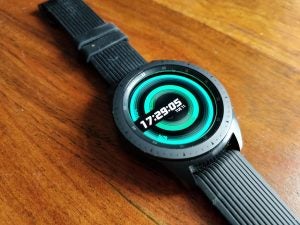
As mentioned, the Samsung Galaxy Watch is available in either 42mm (£279) or 46mm (£299) models. The differing physical casing sizes result in differences in display size: 1.2-inch for the 42mm vs 1.3-inch for the 46mm. Both models feature the same 360 x 360 AMOLED display, so you’ll get fractionally lower pixel density in the larger model, but this isn’t at all obvious to the eye.
Related: Samsung Galaxy Watch Active review: Is this sportier version better?
The display remains sharp and bright, and it’s easily legible outdoors – even if Samsung doesn’t match the bold claims of 1000 nits on the new Apple Watch models.
The display is once again surrounded by the rotating bezel seen on all of Samsung’s latest circular smartwatches. I’ve always found this to be an elegant solution to the problem of your fingers obstructing a small display when swiping around menus. It’s a similar approach to the Apple Watch’s Digital Crown, but even more tactile thanks to the satisfying physical clicks of the magnets as it rotates. The sensation is a bit like cracking open a safe.
Related: Apple Watch 4
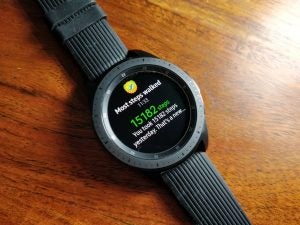
The screen is flanked by a menu and back button with a microphone in-between. The other side is home to a small speaker that allows Bixby to read out information. With specific watch faces that feature a moving second hand, you’ll also hear the distinct ticking of the hand rotating – an oddly delightful discovery when I was lying down in bed one night.
Flip the watch over and there’s an optical heart rate monitor that can take readings throughout the day. Like the Gear Sport, the Galaxy Watch is rated to 5-ATM, so you’re safe to take it down to depths of 50 metres. Even if you’re not a swimmer, just being able to wear it in the shower is a real bonus. If you’re using it to keep tabs on your activity throughout the day, any time you take a tracker off is an opportunity to forget to put it back on.

Of the two sizes, I was sent the smaller, 42mm model for review – which is a better fit for my wrist. The 42mm model’s design is reminiscent of the Galaxy Sport I reviewed previously, meaning it weighs 49g (without the strap) and is 12.7mm thick — significantly less cumbersome compared to the Gear S3 previously.
The Midnight Black model is also less brash than the very sports-centric design of the Galaxy Sport paired with vibrant blue strap. A Rose Gold finish is also available in the 42mm size, while Silver is an exclusive option for 46mm models.
Both models have interchangeable standard straps, so you can easily swap these out for something that better fits your taste — and we recommend that you do. I found the black silicone band that comes as standard had a habit of picking up dirt and lint easily, leaving the unit looking especially grubby after exercise.
Samsung Galaxy Watch – Performance and apps
On the inside, the Galaxy Watch packs an Exynos 9110 dual-core processor clocked at 1.15GHz, paired with 768MB of RAM and 4GB of internal storage. That’s a modest processor speed boost compared to the Gear Sport, but it isn’t something you’ll notice considering the Gear Sport was no slouch.
Earlier rumours of Samsung returning to Google’s stable and launching a Wear OS-powered smartwatch were off the mark, so Tizen makes a return yet again. In truth, the overall OS experience feels more or less identical to that of the Gear Sport. It’s an OS built to take advantage of that rotating bezel, so quick twists let you swap between interfaces with ease, with all the information you need generally placed where you want it by default or through customisation.
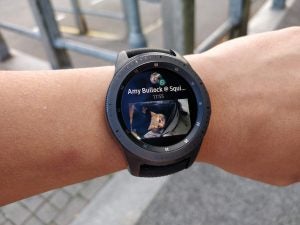
Widgets can be dragged and dropped as you like them. So, if you prioritise the weather or your music controls then you can place these closer to the home watch face by rotating right. All of your notifications are available by rotating left, and can all be cleared with one tap to avoid overload. You’re also able to respond to incoming messages, both SMS and WhatsApp, either through voice, pre-canned messages or an on-screen keyboard.
Apps are laid out in a clock-like fashion, with you rotating the bezel to select them or simply using the touchscreen. But apps remain Tizen’s Achilles’ heel: there simply aren’t enough of them in comparison to Apple’s watchOS or even Google’s Wear OS. When developers are already de-prioritising app development for both of these prevalent operating systems, there isn’t much hope left for Tizen.

My most-used smartwatch apps in recent months have been home automation-related, and these are absent. There’s even a dearth of navigation apps – my other primary use for a smartwatch. Scroll through the Galaxy Apps store and it’s just third-party options, many of which have low review scores for functionality.
Bixby as a voice assistant is a moderate improvement over S Voice, but it still isn’t particularly great. It remains slow to respond, often complaining it doesn’t have a Wi-Fi connection even though it should have. It’s also poor at responding to the natural-language questions you’d expect it to get right.
It at least manages the basics, such as setting an alarm; but even then I had to be very specific and ask for ‘an alarm in 20 minutes’ to ensure I didn’t burn my dinner. Asking for a ’20-minute timer’ meant having to install the separate Timer app, which was confusing and irritating.
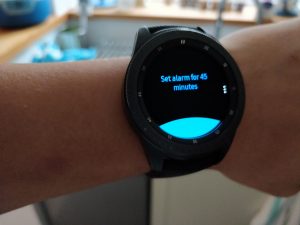
Samsung Pay is supposed to take care of your contactless payments – but with so many banks yet to get on board, including mine, it remains another frustration.
As with the Gear Sport, the redeeming factor for the Galaxy Watch is its Spotify support. Samsung’s Tizen devices remain one of the few that support Spotify offline playback, so you can make use of your 4GB of internal storage to download your favourite music (as long as you’re a Spotify subscriber). You’re then free to pair Bluetooth headphones and leave your phone at home or in your gym locker if you’re wanting accompanying tunes for your workout.
Samsung Galaxy Watch – Fitness tracking and workouts
The Galaxy Watch really follows the blueprint of the Gear Sport when it comes to activity tracking – and that’s no bad thing. Inside, it features the same GPS and GLONASS support of the Sport, working alongside the optical heart rate monitor, accelerometer and barometer.
Between all of the data captured across these sensors, the Galaxy Watch manages to be pretty informed when it comes to your activity through the day and night. And its strength is in how it uses this data to motivate you through helpful prompts, pats on the back when you achieve your targets and records your activities automatically.

If you were to set out on a walk, after 10 minutes it will start recording your walk as an activity by default, tallying up your steps on the display and prompting you to maintain your healthy pace. I was testing the Galaxy Watch whilst on holiday, where I happened to be spending a lot of time walking anyway. The little vibrations on my wrist did really make me want to carry on once the 10-minute marker has automatically kicked in.
The barometer keeps tabs of the flights of stairs you climb, and the watch will set you a floor target in the way you would a step goal. Receiving a notification to say that the previous day set a new record was surprisingly rewarding. For anyone who’s tempted to not walk up the escalator or to use the lift, it’s a great way to make you want to take those stairs instead.
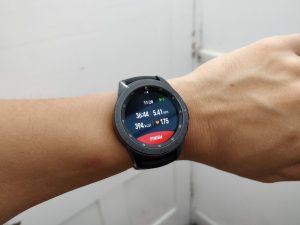
Other small victories include getting to bed on time and waking up at the right time, alongside the usual medals for distance and pace for outdoor workouts.
Samsung is using the heart rate monitor to take stress level readings throughout the day now, too, similar to Apple’s and Fitbit’s implementations. That means there are guided breathing exercises designed to help relieve stress. Admittedly, I still don’t really find these particularly useful, but it’s good to know the option is available.
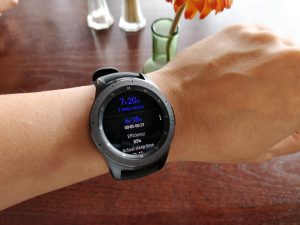
The sleep tracking isn’t as in-depth as I’d like it to be, especially when compared to the Huawei TalkBand B5 I was wearing simultaneously. Fitbit and Huawei both provide greater detail and insight into your sleep quality, as well as offering tips on how to improve your snooze.
Take the Galaxy Watch out for a run and it performs just as well as the Gear Sport. You get the right amount of information available on the display, as well as spoken metrics from the speaker to make you aware of your progress. Distance and heart rate measurements were around what I would have expected.
There’s a whole range of other workouts available on the Galaxy Watch, with the total tally now bolstered to 39. There’s everything from lunges to deadlifts available. Anything with a pronounced movement of the watch can track reps; otherwise, you just get duration and heart rate data as you progress through your workout. You can now add additional exercises to the same workout – again, similar to the Apple Watch – but the process is still a little too involved, and I found myself having to correct rep counts on certain exercises.
Samsung Galaxy Watch – Battery life and charging
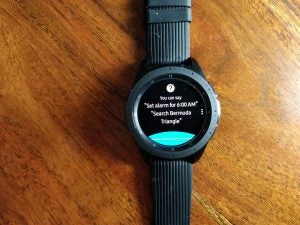
The other difference between the 42mm and 46mm models is the battery size. The former has a 270mAh battery compared with a 476mAh battery in the larger model. That’s a whopping difference. As such, Samsung rates the 46mm model for 7 days, versus 4 days for the 42mm model.
In reality, the 42mm model would just about see you through three days with the always-on display mode turned off. With this function enabled, it was south of 2.5 days — and that’s without any use of GPS, which also quickly depletes the battery. Throw in some Bluetooth music and you’ll want to be charging on a nightly basis.
Overall, it’s a similar experience to the Gear Sport. Therefore, some moderately careful battery management might be in order depending on your usage.
Conveniently, the same magnetic charging stand props up the watch up as a bedside clock and connects through micro-USB.
Samsung Galaxy Watch – 4G LTE
The Galaxy Watch is also available in a 4G LTE flavour. We tested this model separately from the Wi-Fi-only model used for the majority of this review.
Adding 4G into the mix grants Galaxy Watch wearers an additional layer of freedom, letting you leave your phone at home altogether, provided that you’re willing to fork out the extra cash for a secondary contract.

In the UK, EE is the sole carrier to support the 4G variant of the Galaxy Watch. To add the 42mm Galaxy Watch 4G to your standard phone plan costs £20 a month for 24 months; the same is true for the 46mm version, plus an additional charge of £20 upfront.
What quickly becomes apparent is that even light use of the watch’s 4G functionality has a notable impact on battery life, dramatically reducing the 4-day or 7-day longevity Samsung promises with the Wi-Fi-only variants.
While offline Spotify support is a huge selling point for the Gear and Galaxy Watch family, 4G functionality means you aren’t confined to locally stored tunes when you’re away from your phone. This will require some fiddling of the watch’s connectivity and local Spotify app settings; however, once configured I could browse, search and stream over 4G just as I’m used to doing on my smartphone.
Streaming 30 minutes of Muse’s “Simulation Theory” over EE’s 4G network while using Bluetooth headphones saw the watch’s battery drop by a considerable 12%. This suggests you might have sufficient power to browse and stream on your commute to and from work, so long as you don’t use the device for all that much else in-between.
There’s also the matter of the reliability of the connection. With such a small antenna concealed within the watch’s body, I wasn’t all that surprised to discover streaming quality nosedived on a packed commuter train on my way home from work.
This wasn’t just a cellular issue, mind – although that was part of the problem. The watch and my AirPods, too, had a tough time keeping their wireless tether intact. However, this is an issue I also encounter with some smartphones when in similar conditions.
Take a call when you’re away from your phone and the watch’s integrated microphones and speaker make for a surprisingly good surrogate.
I was pleasantly surprised by the call quality for those on the receiving end. The watch did a great job of suppressing background noise on a busy London street, ensuring my friend’s voice came through loud and clear. While it’s best to speak directly into the watch, the Galaxy Watch can actually handle being a little further away from your face – which is ideal if you have your hands full carrying shopping, for example.
As for the device’s loudspeaker, it’s wholly serviceable, with clear audio and impressive depth considering this is a watch we’re talking about. Don’t expect proper bass when playing music, though. In fact, we’d entirely avoid playing music via the watch’s speaker; it butchers the sound quality and will only annoy those around you. As for calls, we’d recommend to only use it sparingly – ideally with some Bluetooth buds if you plan on chatting regularly.
For those curious about the 4G version’s 1.5GB of RAM (versus the Wi-Fi-only model’s 768MB), there’s no discernible difference in everyday performance when it comes to smoothness and interactivity.
To round out the 4G-specific differences, let’s talk battery life. Streaming 30 minutes of Spotify, taking a quick call, plus a number of other tasks that the Galaxy Watch is meant for (such as checking the weather, controlling music playback when connected to my phone, sleep tracking and so on), saw the 472mAh battery last about 35 hours. This falls some way short of the 7-day promise of the Wi-Fi-only model but is still good by general smartwatch standards and particularly impressive considering cellular use is factored in here.
As for recharging, the 4G version consistently reached full capacity after around three hours on its dock, although it recovers about 35% juice after one hour and just over 70% after two hours.
Why buy the Samsung Galaxy Watch?
The Galaxy Watch is the most rounded, accomplished Samsung smartwatch to date, thanks to its elegant and comfortable design, array of sensors that make it great for sports and activity tracking, and general smartwatch conveniences.
Apps remain a shortcoming, even if the great Spotify implementation still sets Tizen apart. But nowadays, the “lack of apps” charge can be levelled at other rivals, too, so it’s starting to become less of an issue over which to penalise Tizen – just as long as you know what you’re in for, and set your expectations accordingly.
Overall, the Galaxy Watch gets the core features right at a price point that makes it good value. If you’re after a sporty smartwatch that’s a little more understated, it’s much-improved over the Gear Sport.
Verdict
Samsung’s best smartwatch to date, offering a good balance of sports and smartwatch functionality.



